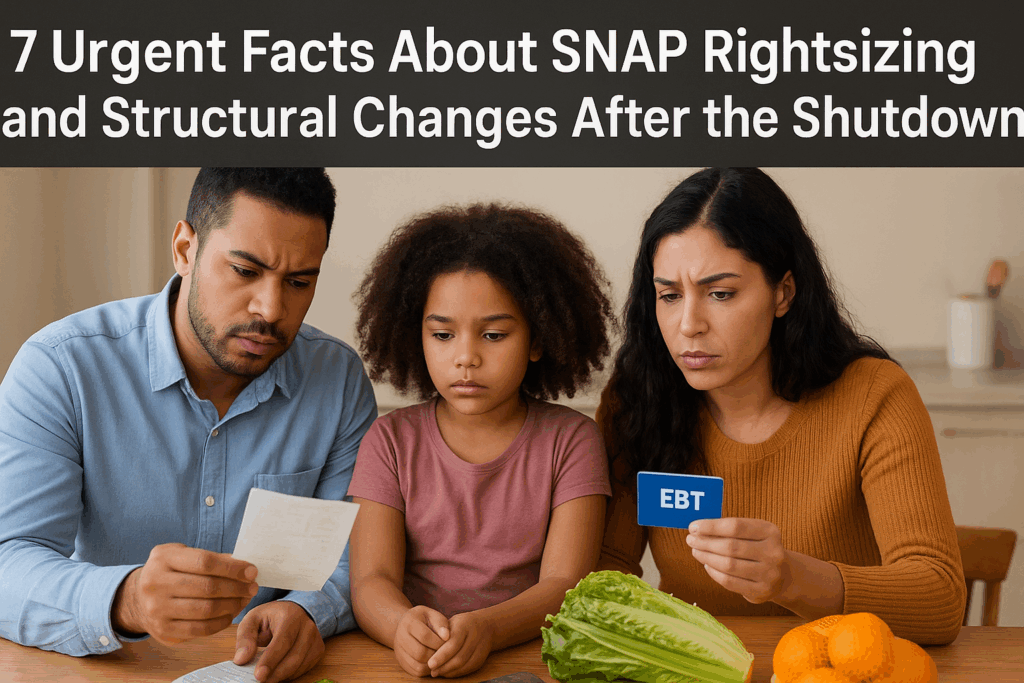Major Takeaways
SNAP is facing major rightsizing measures that could force millions of households to reapply, tighten eligibility, and reshape how benefits are delivered.
The shutdown exposed deep structural weaknesses in the program, creating late payments, partial benefits, and widespread community strain.
Proposed federal changes could reduce benefits, increase state costs, and hit working families, older Americans, and low income households the hardest.

Urgent Facts About SNAP Rightsizing and Structural Changes After the Shutdown In 2026
The Supplemental Nutrition Assistance Program, better known as SNAP, is standing in the middle of one of the biggest shakeups it has seen in decades. More than forty two million Americans rely on these benefits every month. But after the recent forty three day government shutdown, the program is being pushed into what federal officials are calling rightsizing and structural changes.
That is political speak for a whole lot of uncertainty.
SNAP is already a massive program. A typical month costs around nine billion dollars. When the shutdown hit, the Department of Agriculture had only about six billion dollars available in its contingency fund. That meant the department could not fully fund the program even if it wanted to. After legal pressure and internal debate, federal officials chose to release roughly half the money needed for the month. That meant millions of people received partial benefits or faced delays as states scrambled to adjust their systems.
To make matters worse, new applicants were told they would not receive benefits for the month at all since the department was only covering existing recipients. Some states warned residents that their cards might not reload on time. Others advised families to prepare for smaller payments than usual. A few even explained that they might not be reimbursed if they tried to front the cost themselves.
This created a ripple effect. Delayed benefits turned into empty shelves. Working parents who budget down to the penny suddenly had to stretch even harder. Community food banks were already strained before the shutdown. After it, many were overwhelmed.
Then came the next shoe to drop.
Federal officials began talking openly about the need to rethink the SNAP program from top to bottom. Instead of temporary “shutdown adjustments,” they argued the system requires permanent structural repairs. The phrase rightsizing became the centerpiece of every interview and press briefing. According to officials, state data showed that some recipients were listed under duplicate accounts and that some individuals who had passed away were still on the rolls. They claim the only way to clean up the system is to require millions of households to reapply so officials can verify who should remain eligible.
For many families, that is not a minor ask. Reapplying means scheduling appointments, submitting documents, finding transportation, and hoping the state office has enough staff to process the backlog. For elderly residents, families with disabilities, and people living on tight schedules, a reapplication wave could push them off the program simply because they cannot navigate the process fast enough.
Behind the scenes, there is a much larger political push shaping all of this. Congress is considering a wide ranging budget package that would reshape how SNAP operates over the next decade. The proposals include tighter work requirements for adults up to age sixty four, new restrictions on who qualifies as part of a household, and a shift that forces states to pay a portion of the actual food benefit cost. That is a dramatic change. If states cannot afford it, they might cut benefits or reduce enrollment.
Analysts studying the proposals warn that more than twenty million families could be affected. Some would lose at least twenty five dollars a month. Others might lose eligibility entirely. Many of the families expected to be hit the hardest are working households, single parents, and older Americans who already rely on SNAP to fill the gap between income and rising food prices.
Critics argue that these structural changes could increase hunger nationwide. They warn that forcing states to shoulder costs could lead to benefits being slashed during recessions or budget shortfalls. Some advocates say the reapplication requirement is less about catching fraud and more about pushing people out of the program through paperwork burdens.
Supporters of reform insist the changes are necessary to make the program more efficient. They argue that tightening eligibility, increasing work requirements, and asking states to share responsibility will reduce waste and improve accountability. They say the program has grown too large and needs to be brought back to what they describe as its original purpose.
The truth is that both sides know exactly what is at stake. SNAP is not just a budget item. It is a lifeline. Millions of families plan their entire food budget around their monthly benefit load. When the system shakes, their pantries shake with it.
The next round of announcements is expected soon, and states will have to prepare for whatever new rules come down. That means new systems, new paperwork, new rules for eligibility, and possibly new legal fights over how far the federal government can go.
While the political world debates numbers and formulas, regular people are simply trying to eat. They are trying to feed their kids. They are trying to stretch a dollar in an economy where groceries have risen faster than wages for years.
For Urban City readers and listeners, this story matters because the impact hits close to home. SNAP is widely used across urban neighborhoods, rural communities, and everywhere in between. Empty fridges lead to tough decisions. Tough decisions lead to real stress. And real stress hits families and communities harder than any debate on the Senate floor.
So here is the bottom line. SNAP is about to change. The shutdown revealed just how fragile the support structure really is. Now federal leaders say they want to reshape the program permanently. Whether those changes strengthen or weaken the safety net depends on what happens in the coming months.
What is clear is that millions of people who rely on SNAP should be paying attention. Rightsizing is a nice word, but it does not put food on the table. Structural changes sound orderly, but the impact could be chaotic on the ground. And when the dust settles, the country might end up with a very different version of the program that has fed Americans for more than sixty years.














